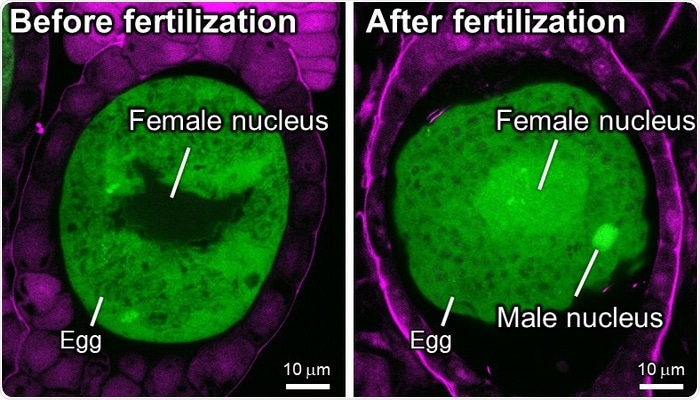At times the answers to fundamental questions can be in plain view in research too. Scientists from Japan have identified a major piece of the puzzle of plant evolution earlier ignored by plant researchers.

Egg cells of the liverwort Marchantia polymorpha before (left) or after (right) fertilization. Green and magenta colors indicate localization of MpKNOX1-GFP proteins and maternal tissues, respectively. Note that fertilization triggers enrichment of MpKNOX1-GFP in unfused male and female nuclei. Image Credit: Tetsuya Hisanaga and Keiji Nakajima.
A group of scientists headed by the Nara Institute of Science and Technology showed that an ancestral function of the plant KNOX/BELL proteins is zygote activation (zygotes are the first diploid cell created by the fusion of female and male gametes, also called reproductive cells). This role later changed towards the maintenance of organ development at the time of the evolution of land plants. The research was published in the eLife journal.
One major question in developmental biology is the mixing of parental genomes in a zygote and their activation to start diploid development. The two proteins, KNOX and BELL, operate as transcription factors—proteins that perform a vital role in gene expression.
KNOX and BELL activate diploid development in plants like a unicellular green alga; however, in land plants like angiosperms (flowering plants), they play a role in the maintenance of the shoot meristem—the tissue that creates the whole of the plant growing above the ground—and the mechanism of organ formation in the subsequent stages of diploid development.
It’s unknown if the differing functions of KNOX and BELL were attained separately in land plants and algae. Although mostly dismissed from the spotlight by plant biologists until now, the zygote-activating functions of algal KNOX/BELLs, and how they relate to those of land plants, were the focus of this study.”
Keiji Nakajima, Study Senior Author, Nara Institute of Science and Technology
The scientists, to analyze this, inspected a basal land plant species, the liverwort Marchantia polymorpha, which is now identified as a better model for analyzing the evolution of land plants, particularly in sexual reproduction research.
The researchers identified that gamete-expressed KNOX and BELL genes are required to start zygote development by encouraging nuclear fusion in the zygote similar to that found earlier in the green alga Chlamydomonas reinhardtii.
Our results suggest that the ancestral role of KNOX/BELL transcription factors is zygote activation. As land plants evolved, this moved toward meristem maintenance.”
Keiji Nakajima, Study Senior Author, Nara Institute of Science and Technology
The findings of the research would be vital for plant biologists experimenting across a range of areas like embryo and organ formation, sexual reproduction, and evolution. The results along with the proposal of a similar scenario in groups like fungi and animals might also be appropriate to scientists in broader biological sciences.
Source:
Journal reference:
Hisanaga, T., et al. (2021) Deep evolutionary origin of gamete-directed zygote activation by KNOX/BELL transcription factors in green plants. eLife. doi.org/10.7554/eLife.57090.